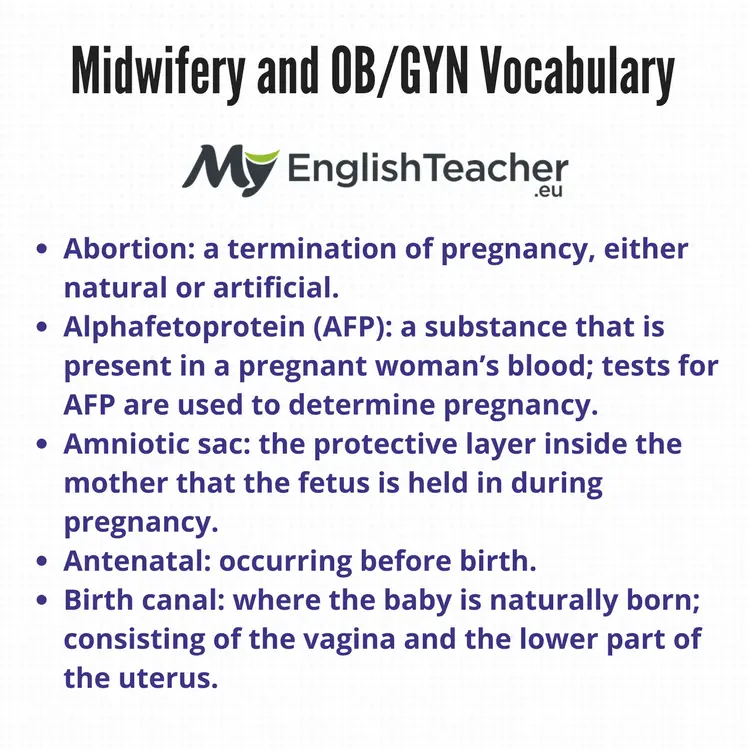
If you work with new mothers and babies, you have a really important job! Not only do you keep children healthy, but you make sure they are taken care of when they are first born. Here are some English words that are related to OB/GYN and midwifery.
- Abortion: a termination of pregnancy, either natural or artificial.
- Alphafetoprotein (AFP): a substance that is present in a pregnant woman’s blood; tests for AFP are used to determine pregnancy.
- Amniotic sac: the protective layer inside the mother that the fetus is held in during pregnancy.
- Antenatal: occurring before birth.
- Birth canal: where the baby is naturally born; consisting of the vagina and the lower part of the uterus.
- Birth control: any practice of preventing pregnancy.
- Breastfeeding: the process of feeding an infant from a mother’s breast; pure breastfeeding (no other foods) is recommended for infants 0-6 months.
- Caesarean section: a surgical procedure used to deliver babies when a natural birth is impractical or potentially dangerous to the mother or infant.
- Cervix: the bottom part of the uteru.
- Contraception: any kind of birth control that specifically applies to preventing pregnancy in the face of sexual intercourse.
- Crowning: a stage of giving birth when the fetus’ head is visible; this occurs immediately before the fetus is born.
- Delivery: the process through which the doctor, nurse, and/or midwife helps birth the baby.
- Ectopic Pregnancy: a pregnancy that occurs in the fallopian tubes, not the uterus, that can cause serious harm to the mother if left untreated.
- EDD: expected date of delivery; when the birth of the infant is expected.
- Endometriosis: a condition that occurs when the endometrium is found outside the uterus; can lead to pain and heaving bleeding.
- Endometrium: the layer that lines the uterus; it is made of mucus and fills with blood and nutrients during the menstrual cycle; its shedding leads to the menstrual period.
- Episiotomy: a cut made in the mother’s perineum (the section between her vagina and anus) that allows the baby to be born with minimal complications.
- Fetus: an unborn baby that is still developing in the mother’s body.
- FH: fetal heart.
- FM: fetal movement.
- Fundus: the top of the uterus; the height measurements helps assess the growth and development of the fetus and how many weeks it has been growing.
- Gynecologist: a doctor specializing in women’s health.
- Hysterectomy: a surgical procedure used to remove all or part of the uterus.
- Infant: a newborn baby.
- Infertility: an inability to get pregnant and maintain the fetus to birth.
- Labor: the process of birthing the fetus; it begins with the first uterine contraction and ends when the placenta has been delivered.
- LMP: last menstrual period; this date is asked of the mother and helps determine when she became pregnant so an expected date of delivery can be determined.
- Mammogram: a medical examination of the breasts.
- Mastectomy: a surgical procedure to remove part or all of the breasts; can be done to prevent a disease (such as breast cancer) or after such a disease has developed.
- Menopause: the period in a woman’s life when the menstrual period ceases and her body undergoes various hormonal changes.
- Menstrual Cycle: the cycle of menstruation, shedding of the uterine lining, and reformation of the uterine lining.
- Menstruation: the process that women experience when she discharges blood and other material from the uterus when she is not pregnant.
- Menstrual Period: another word for menstruation.
- Midwife: a trained professional who helps a woman deliver her baby.
- Miscarriage: a natural termination of pregnancy.
- Morning Sickness: the tendency for some pregnant women to feel sick in the morning.
- Multigravida: describing a woman who has been pregnant before, including miscarriages and abortions that did not lead to giving birth.
- Multipara: describing a woman who has given birth before; does not include miscarriages and abortions that did not lead to giving birth.
- NAD: nothing abnormal detected, meaning that the fetus appears to be developing normally.
- Neonatal: in the period right after birth.
- Obstetrician: a doctor specializing in pregnant women and pregnancy.
- Occipito Anterior: the position of the fetus when the face is towards your spine.
- Occipito Posterior: the position of the fetus when the face is towards your belly button.
- Ovary: the female organs that hold unfertilized eggs.
- Ovarian Artery: the artery that bring blood to the ovaries.
- Palpation: the ability of the doctor or midwife to feel the baby’s movement by touching the mother’s stomach.
- Pap Smear: a test that is part of a screening process for cervical cancer.
- PIH: pregnancy-induced hypertension, or an instance of high blood pressure due to pregnancy; if not managed, the hypertension may persist after birth.
- Placenta: the organ through which the mother provides nutrition to the fetus and helps remove waste products during pregnancy; has a protective effect to the unborn baby.
- Postnatal: after the birth.
- Premature: a baby that is born before its due date and may be more vulnerable to different diseases or health problems.
- Preterm: a premature baby (born before 37 weeks of pregnancy).
- Prigravida: describing a woman who has not been pregnant before, including miscarriages and abortions that did not lead to giving birth.
- Pripara: describing a woman who has not given birth before; does not include miscarriages and abortions that did not lead to giving birth.
- Skin-to-Skin: the contact between the infant and the mother of skin to skin right after birth; this type of contact is said to improve health of both the mother and baby.
- Stillbirth: when a baby is born dead.
- Ultrasound: a scan that is used for pregnant women to allow them to see their fetus during checkups.
- Umbilical Cord: the cord that connects the placenta and the fetus.
- Uterine Artery: the artery that brings blood and nutrients to the uterus.
- Uterus: the organ in the mother in which the fetus grows.
- Womb: another term for the uterus, usually referring to the uterus during pregnancy.

























I’m 11 years old and I plan to become an obstetrician when I’m older, this has really helped me! Thank you!!!
Wow, so glad to hear from you! Keep learning! 🤓
I’m 14 years old and I’d like to be a Midwife when I’m older, I just added all this vocab to my list, thank you so much!!!!!